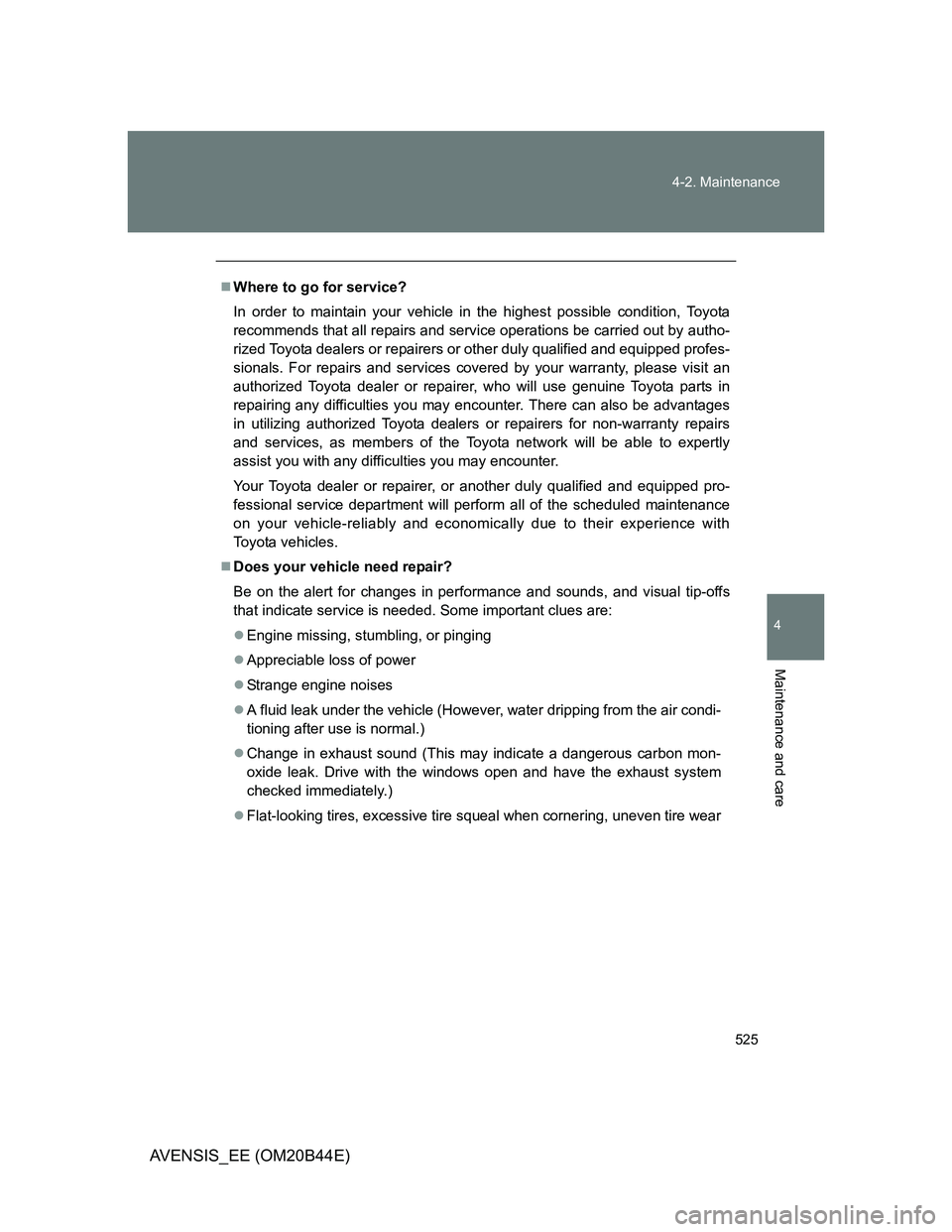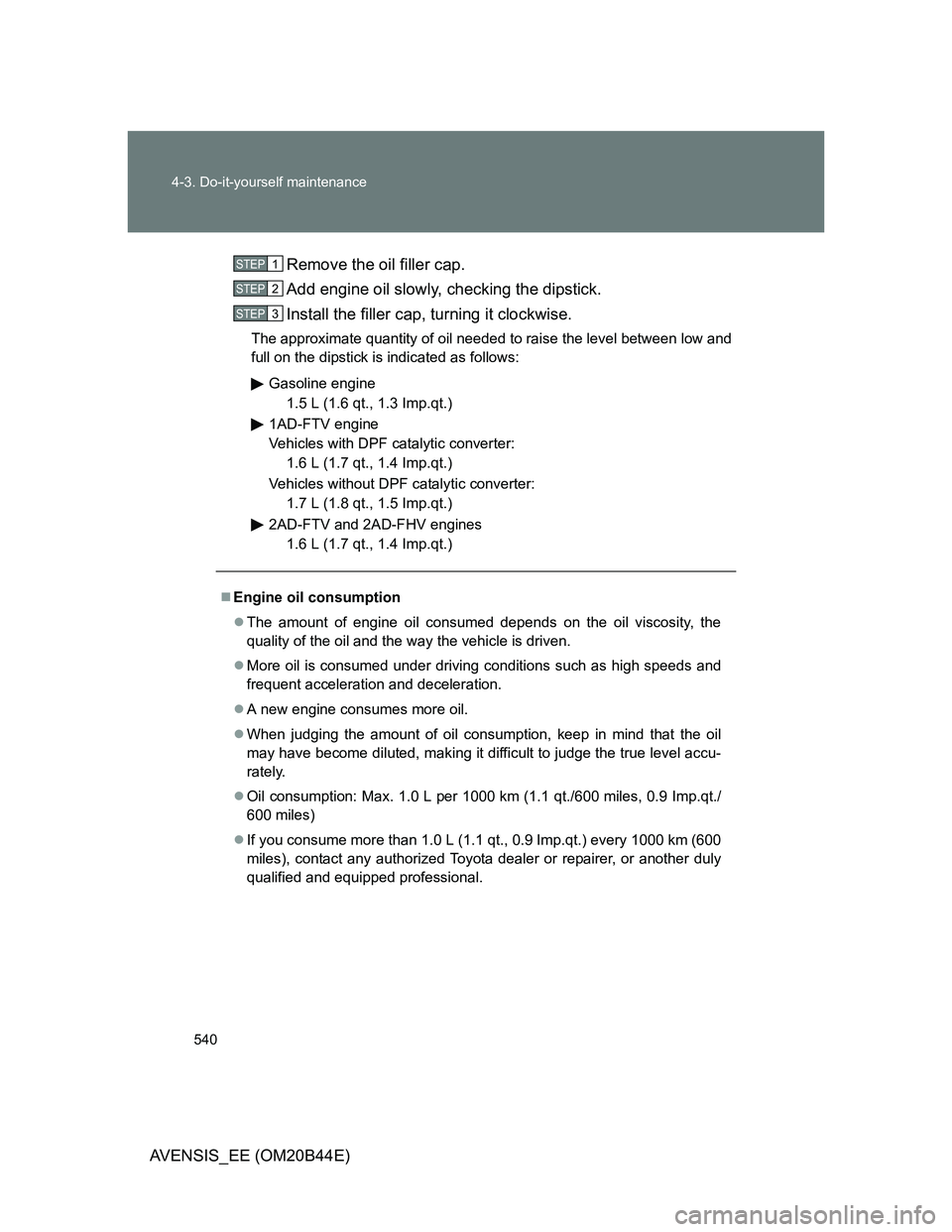Page 380 of 772

380 3-1. Using the air conditioning system and defogger
AVENSIS_EE (OM20B44E)
NOTICE
To prevent damage to your vehicle
Do not turn the heater on and off repeatedly in 5 minute intervals as this
can shorten the life of the heater components. If the engine must be turned
on and off repeatedly within short intervals (such as when the vehicle is
being used for delivery purposes), turn the heater off.
Do not modify or open the heater without consulting any authorized Toyota
dealer or repairer, or another duly qualified and equipped professional.
This may cause a heater malfunction or a fire.
Be careful not to splash water or spill liquid directly on the heater or on the
heater fuel pump. This may cause the heater to malfunction.
Keep the intake and exhaust pipes of the heater free from water, snow,
ice, mud, etc. If the pipes become clogged, this can cause the heater to
malfunction.
If you notice anything unusual, such as a fluid leak, smoke or poor opera-
tion, turn off the heater and have your vehicle checked by any authorized
Toyota dealer or repairer, or another duly qualified and equipped profes-
sional.
Page 381 of 772
381
3-1. Using the air conditioning system and defogger
3
Interior features
AVENSIS_EE (OM20B44E)
Rear window and outside rear view mirror defoggers
The rear window and outside rear view mirror defoggers can be oper-
ated when
Vehicles with smart entry & start system
The “ENGINE START STOP” switch is in IGNITION ON mode.
Vehicles without smart entry & start system
The engine switch is in the “ON” position.
CAUTION
When the outside rear view mirror defoggers are on
Do not touch the rear view mirror surfaces, as they can become very hot and
burn you.
Clear the rear window using the defogger. (Turning the rear window
defogger on will turn the outside rear view mirror defoggers on. The
outside rear view mirror is used to remove raindrops, dew and frost
from the outside rear view mirrors.)
On/off
The defoggers will automati-
cally turn off after approxi-
mately 15 minutes. Pressing
the switch again also turns the
rear window defogger off.
Page 382 of 772
382
3-1. Using the air conditioning system and defogger
AVENSIS_EE (OM20B44E)
Windshield wiper de-icer
: If equipped
The windshield wiper de-icer can be operated when
Vehicles with smart entry & start system
The “ENGINE START STOP” switch is in IGNITION ON mode.
Vehicles without smart entry & start system
The engine switch is in the “ON” position.
CAUTION
When the windshield wiper de-icer is on
Do not touch the glass at the lower part of the windshield or to the side of the
front pillars as the surfaces can become very hot and burn you.
This feature is used to prevent ice from building up on the wind-
shield and wiper blades.
On/off
The windshield wiper de-icer
will automatically turn off after
approximately 15 minutes.
Pressing the switch again also
turns the de-icer off.
Page 464 of 772
464 3-2. Using the audio system
AVENSIS_EE (OM20B44E)
Adjusting the ring tone volume when receiving a call
To decrease the volume: Press .
To increase the volume: Press .
When talking on the phone
Do not talk simultaneously with the other party.
Keep the volume of the received voice down. Otherwise, voice echo will
increase.
Automatic volume adjustment
When vehicle speed is 80 km/h (50 mph) or more, the volume automatically
increases. The volume returns to the previous volume setting when vehicle
speed drops to 70 km/h (43 mph) or less.
Phone call system functions
Depending on the cellular phone, certain functions may not be available.
Situations where the system may not recognize your voice
When driving on a rough road
When driving at high speeds
When air is blowing out of the vents onto the microphone
When the air conditioning fan emits a loud noise
Page 515 of 772
4Maintenance and care
515
AVENSIS_EE (OM20B44E)
4-1. Maintenance and care
Cleaning and protecting
the vehicle exterior ......... 516
Cleaning and protecting
the vehicle interior .......... 521
4-2. Maintenance
Maintenance
requirements................... 524
4-3. Do-it-yourself maintenance
Do-it-yourself service
precautions ..................... 527
Hood ................................. 531
Positioning a floor jack ...... 533
Engine compartment......... 535
Tires .................................. 552
Tire inflation pressure ....... 556
Wheels .............................. 558
Air conditioning filter ......... 560
Key battery........................ 564
Checking and replacing
fuses ............................... 569
Light bulbs ........................ 585
Page 525 of 772

525 4-2. Maintenance
4
Maintenance and care
AVENSIS_EE (OM20B44E)
Where to go for service?
In order to maintain your vehicle in the highest possible condition, Toyota
recommends that all repairs and service operations be carried out by autho-
rized Toyota dealers or repairers or other duly qualified and equipped profes-
sionals. For repairs and services covered by your warranty, please visit an
authorized Toyota dealer or repairer, who will use genuine Toyota parts in
repairing any difficulties you may encounter. There can also be advantages
in utilizing authorized Toyota dealers or repairers for non-warranty repairs
and services, as members of the Toyota network will be able to expertly
assist you with any difficulties you may encounter.
Your Toyota dealer or repairer, or another duly qualified and equipped pro-
fessional service department will perform all of the scheduled maintenance
on your vehicle-reliably and economically due to their experience with
Toyota vehicles.
Does your vehicle need repair?
Be on the alert for changes in performance and sounds, and visual tip-offs
that indicate service is needed. Some important clues are:
Engine missing, stumbling, or pinging
Appreciable loss of power
Strange engine noises
A fluid leak under the vehicle (However, water dripping from the air condi-
tioning after use is normal.)
Change in exhaust sound (This may indicate a dangerous carbon mon-
oxide leak. Drive with the windows open and have the exhaust system
checked immediately.)
Flat-looking tires, excessive tire squeal when cornering, uneven tire wear
Page 530 of 772

530 4-3. Do-it-yourself maintenance
AVENSIS_EE (OM20B44E)
CAUTION
When working near the electric cooling fan or radiator grille
Vehicles with smart entry & start system
Be sure the “ENGINE START STOP” switch is OFF.
With the “ENGINE START STOP” switch in IGNITION ON mode, the
electric cooling fan may automatically start to run if the air conditioning is
on and/or the coolant temperature is high. (P. 545)
Vehicles without smart entry & start system
Be sure the engine switch is in the “LOCK” position.
With the engine switch in the “ON” position, the electric cooling fan may
automatically start to run if the air conditioning is on and/or the coolant
temperature is high. (P. 545)
Safety glasses
Wear safety glasses to prevent flying or falling material, fluid spray, etc. from
getting in the eyes.
NOTICE
If you remove the air cleaner filter
Driving with the air cleaner filter removed may cause excessive engine wear
due to dirt in the air. Also a backfire could cause a fire in the engine compart-
ment.
If the brake fluid level is low or high
It is normal for the brake fluid level to go down slightly as the brake pads
wear or when the fluid level in the accumulator is high.
If the reservoir needs frequent refilling, it may indicate a serious problem.
Page 540 of 772

540 4-3. Do-it-yourself maintenance
AVENSIS_EE (OM20B44E)Remove the oil filler cap.
Add engine oil slowly, checking the dipstick.
Install the filler cap, turning it clockwise.
The approximate quantity of oil needed to raise the level between low and
full on the dipstick is indicated as follows:
Gasoline engine
1.5 L (1.6 qt., 1.3 Imp.qt.)
1AD-FTV engine
Vehicles with DPF catalytic converter:
1.6 L (1.7 qt., 1.4 Imp.qt.)
Vehicles without DPF catalytic converter:
1.7 L (1.8 qt., 1.5 Imp.qt.)
2AD-FTV and 2AD-FHV engines
1.6 L (1.7 qt., 1.4 Imp.qt.)
Engine oil consumption
The amount of engine oil consumed depends on the oil viscosity, the
quality of the oil and the way the vehicle is driven.
More oil is consumed under driving conditions such as high speeds and
frequent acceleration and deceleration.
A new engine consumes more oil.
When judging the amount of oil consumption, keep in mind that the oil
may have become diluted, making it difficult to judge the true level accu-
rately.
Oil consumption: Max. 1.0 L per 1000 km (1.1 qt./600 miles, 0.9 Imp.qt./
600 miles)
If you consume more than 1.0 L (1.1 qt., 0.9 Imp.qt.) every 1000 km (600
miles), contact any authorized Toyota dealer or repairer, or another duly
qualified and equipped professional.
STEP1
STEP2
STEP3